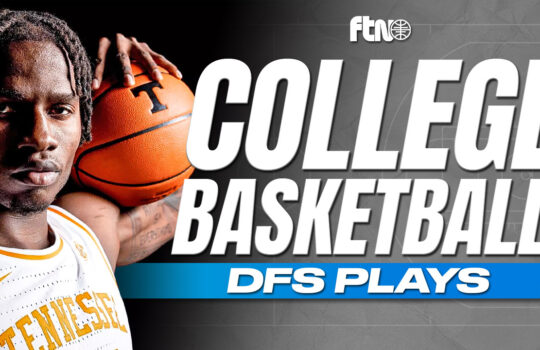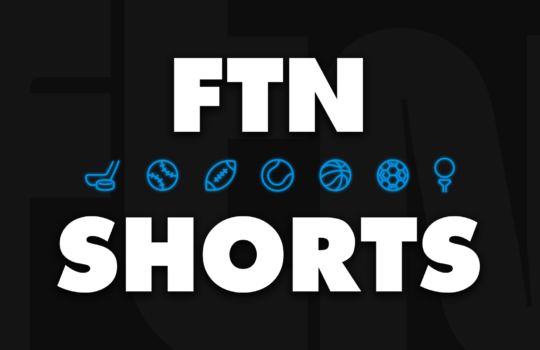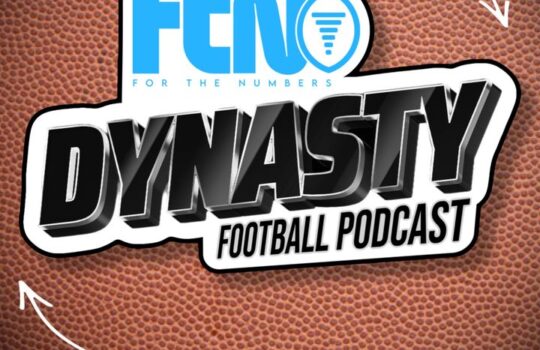
Another year is in the books, and now is the time to self-reflect and see what we got right, what went wrong, and how we can apply those learnings to become better fantasy players in future seasons.
The 2021-2022 fantasy football season was a weird one on many levels. Nobody – literally nobody – could have predicted that Braxton Berrios and Justin Jackson would be leading your squad to fantasy championships come playoff time. But a host of people could have predicted that Joe Burrow and Ja’Marr Chase would be.
Let’s take a trip down memory lane to find out the top 10 things we learned this season.
1. Sometimes, an all-in waiver move early in the season pays huge dividends.
I’m looking at you, Elijah Mitchell and Cordarrelle Patterson. These early-season waiver moves were hotly debated. Before Week 1 even began, people were dropping 100% of FAAB on Mitchell. It turns out, that was one of the best moves you could have made all season. Whether to save FAAB or a waiver position for a more proven player or a more sure situation is always going to be a debate in fantasy. But Mitchell’s strong season will surely have more people pulling the trigger earlier in future years. It won’t always work, of course, but when you’re chasing upside, it’s hard to argue against a player you get all season (injury notwithstanding).
2. Drops do not matter.
See Chase, Ja’Marr. The preseason memes were funny, but it ultimately didn’t matter. The same can be said for Diontae Johnson, who just finished the year with 107 receptions, 1,161 yards and 8 TDs. Unless the player is getting benched and not seeing the field because of drops, you can completely ignore the noise.
3. Supreme athletic talent bubbles to the surface.
I suppose this one isn’t a universal truth, and “supreme athletic talent” can be subjective, but I’m thinking of players like Deebo Samuel breaking out in 2021. We knew he was good. He had high draft capital. He flashed as a playmaker his first two years in the league. All it took was more opportunity and more creative deployment, and he became a fantasy league-winner. You can think of Tony Pollard or AJ Dillon here, too. They forced their way into more playing time simply by being good.
4. Konami Code QBs are still undervalued.
There was no reason Jalen Hurts should have been going in the ninth rounds of fantasy drafts all offseason. On the whole, the Konami QBs are priced appropriately. But some of the less-proven QBs will naturally slide in fantasy drafts. Always, always start there if you want to chase upside.
5. We overreact to unknown preseason injuries.
There was a week, maybe two, in August where absolutely nobody wanted to draft Jonathan Taylor because one of his O-linemen got hurt. Carson Wentz was also hurt around the same time, but he was never expected to miss a tremendous amount of time. The “fade Taylor” thought process became so prevalent that he started going toward the end of the second round in most fantasy drafts. That … was not optimal.
6. The bellcow RB continues to be a dying breed.
I think a fair draft strategy to explore in 2022 and beyond is that unless you know you’re drafting a bellcow – Jonathan Taylor, Christian McCaffrey, Najee Harris, etc. – than you probably shouldn’t draft one until you get to the double-digits of fantasy draft rounds. This isn’t a groundbreaking concept (people have called it the “dead zone” for a few years), but it never seemed more true than in 2021. There are very few bellcows left in the NFL. Even some of the high-volume players aren’t used to their full potential because of players like Nyheim Hines, JD McKissic, etc.
7. You’re still not allowed to call the TE position “deep” – but it did get a little better this year
Rob Gronkowski reemerged, Mark Andrews broke out, Travis Kelce was his usual self, and George Kittle and Darren Waller were their usual selves when healthy. We had TJ Hockenson looking like he was going to have a big breakout year, and we had Dalton Schultz plod his way to a solid season overall. Rookie Kyle Pitts topped 1,000 yards (but frustratingly didn’t score TDs). In short, the depth problem got better this season, but on the whole, TEs largely remained one of the haves and have-nots. Next season may finally see true depth at the position with Pitts entering Year 2, injured stars getting healthy, and players like Dallas Goedert not being blocked half the year.
8. Sometimes, streaks at the end of one season really do give you critical information for the next season.
I’m mostly thinking of Leonard Fournette with this one. The Buccaneers showed us during last year’s playoff run that Uncle Lenny was their guy. Then we entered 2021 fantasy drafts and Ronald Jones went 2-3 rounds ahead of Fournette? We galaxy-brained ourselves out of that one. This year’s end-of-year player is clearly Amon-Ra St. Brown. He deserves to be drafted highly next season.
9. A good slot WR goes a long, long way in fantasy.
Cooper Kupp won the WR triple crown (receptions, yards, TDs). Hunter Renfrow was a fantasy revelation. Jakobi Meyers was startable every week in PPR even without TDs. Darnell Mooney emerged as Chicago’s WR1. Christian Kirk finally produced on a regular basis. Jaylen Waddle was a PPR monster all season long. Even Ray-Ray freaking McCloud became a name to know at the end of the year. The easiest way to a high fantasy floor is through a slot WR.
10. A reminder that TDs are streaky, and your job is to play the variance.
Austin Ekeler scored 3 TDs in 2020. He was hardly used inside the 5, and the fear was that he was going to be TD-barren again in 2021. So much so that he often went in the second round of fantasy drafts. Then he scored 20 TDs. Davante Adams scored 3 TDs from Weeks 1-10. Everyone wondered what was wrong with him. Then he scored twice in Week 11, twice in Week 14, twice in Week 16 and once in Weeks 15 and 17. TDs can be fickle, but red-zone usage goes a long way in telling the story. And as we learned with Ekeler, new coaching staffs can make last year’s data irrelevant.

















































 New York Jets
New York Jets  New England Patriots
New England Patriots  Miami Dolphins
Miami Dolphins  Buffalo Bills
Buffalo Bills  Pittsburgh Steelers
Pittsburgh Steelers  Cleveland Browns
Cleveland Browns  Cincinnati Bengals
Cincinnati Bengals  Baltimore Ravens
Baltimore Ravens  Tennessee Titans
Tennessee Titans  Jacksonville Jaguars
Jacksonville Jaguars  Indianapolis Colts
Indianapolis Colts  Houston Texans
Houston Texans  Las Vegas Raiders
Las Vegas Raiders  Los Angeles Chargers
Los Angeles Chargers  Kansas City Chiefs
Kansas City Chiefs  Denver Broncos
Denver Broncos  Washington Commanders
Washington Commanders  Philadelphia Eagles
Philadelphia Eagles  New York Giants
New York Giants  Dallas Cowboys
Dallas Cowboys  Minnesota Vikings
Minnesota Vikings  Green Bay Packers
Green Bay Packers  Detroit Lions
Detroit Lions  Chicago Bears
Chicago Bears  Tampa Bay Buccaneers
Tampa Bay Buccaneers  New Orleans Saints
New Orleans Saints  Carolina Panthers
Carolina Panthers  Atlanta Falcons
Atlanta Falcons  San Francisco 49ers
San Francisco 49ers  Seattle Seahawks
Seattle Seahawks  Los Angeles Rams
Los Angeles Rams  Arizona Cardinals
Arizona Cardinals 





 Boston Celtics
Boston Celtics  Brooklyn Nets
Brooklyn Nets  Philadelphia 76ers
Philadelphia 76ers  New York Knicks
New York Knicks  Toronto Raptors
Toronto Raptors  Chicago Bulls
Chicago Bulls  Detroit Pistons
Detroit Pistons  Milwaukee Bucks
Milwaukee Bucks  Cleveland Cavaliers
Cleveland Cavaliers  Indiana Pacers
Indiana Pacers  Orlando Magic
Orlando Magic  Atlanta Hawks
Atlanta Hawks  Charlotte Hornets
Charlotte Hornets  Miami Heat
Miami Heat  Washington Wizards
Washington Wizards  Denver Nuggets
Denver Nuggets  Minnesota Timberwolves
Minnesota Timberwolves  Oklahoma City Thunder
Oklahoma City Thunder  Portland Trail Blazers
Portland Trail Blazers  Utah Jazz
Utah Jazz  LA Clippers
LA Clippers  Golden State Warriors
Golden State Warriors  Los Angeles Lakers
Los Angeles Lakers  Phoenix Suns
Phoenix Suns  Sacramento Kings
Sacramento Kings  Dallas Mavericks
Dallas Mavericks  Houston Rockets
Houston Rockets  Memphis Grizzlies
Memphis Grizzlies  New Orleans Pelicans
New Orleans Pelicans  San Antonio Spurs
San Antonio Spurs 










